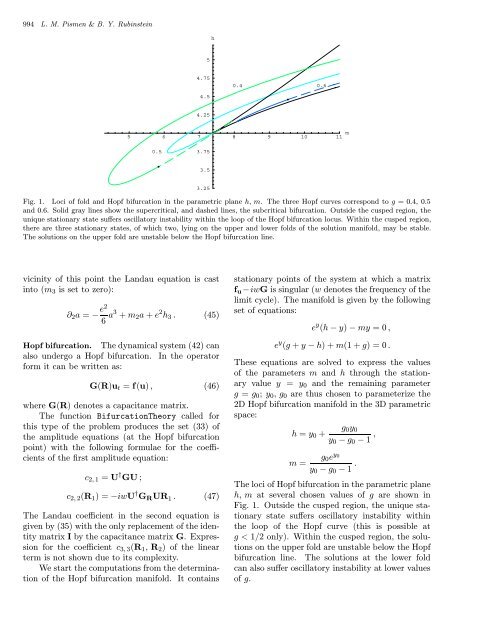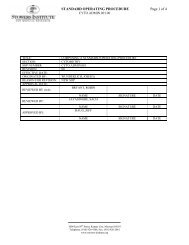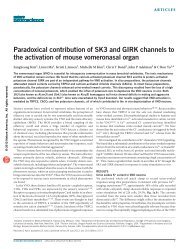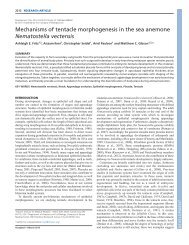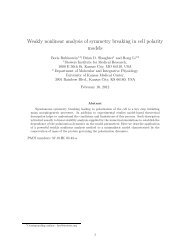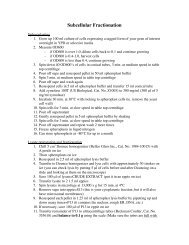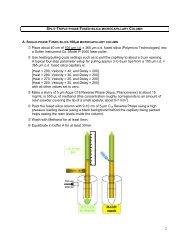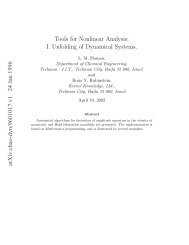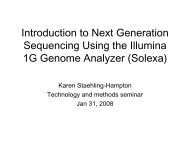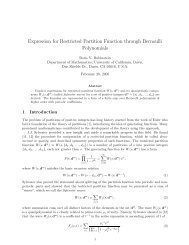Computer Tools for Bifurcation Analysis: General Approach with
Computer Tools for Bifurcation Analysis: General Approach with
Computer Tools for Bifurcation Analysis: General Approach with
You also want an ePaper? Increase the reach of your titles
YUMPU automatically turns print PDFs into web optimized ePapers that Google loves.
994 L. M. Pismen & B. Y. Rubinstein<br />
h<br />
5<br />
4.75<br />
4.5<br />
0.4<br />
0.6<br />
4.25<br />
5 6 7 8 9 10 11 m<br />
0.5<br />
3.75<br />
3.5<br />
3.25<br />
Fig. 1. Loci of fold and Hopf bifurcation in the parametric plane h, m. The three Hopf curves correspond to g =0.4, 0.5<br />
and 0.6. Solid gray lines show the supercritical, and dashed lines, the subcritical bifurcation. Outside the cusped region, the<br />
unique stationary state suffers oscillatory instability <strong>with</strong>in the loop of the Hopf bifurcation locus. Within the cusped region,<br />
there are three stationary states, of which two, lying on the upper and lower folds of the solution manifold, may be stable.<br />
The solutions on the upper fold are unstable below the Hopf bifurcation line.<br />
vicinity of this point the Landau equation is cast<br />
into (m 3 is set to zero):<br />
∂ 2 a = − e2<br />
6 a3 + m 2 a + e 2 h 3 . (45)<br />
Hopf bifurcation. The dynamical system (42) can<br />
also undergo a Hopf bifurcation. In the operator<br />
<strong>for</strong>m it can be written as:<br />
G(R)u t = f(u) , (46)<br />
where G(R) denotes a capacitance matrix.<br />
The function <strong>Bifurcation</strong>Theory called <strong>for</strong><br />
this type of the problem produces the set (33) of<br />
the amplitude equations (at the Hopf bifurcation<br />
point) <strong>with</strong> the following <strong>for</strong>mulae <strong>for</strong> the coefficients<br />
of the first amplitude equation:<br />
c 2, 1 = U † GU ;<br />
c 2, 2 (R 1 )=−iwU † G R UR 1 . (47)<br />
The Landau coefficient in the second equation is<br />
given by (35) <strong>with</strong> the only replacement of the identity<br />
matrix I by the capacitance matrix G. Expression<br />
<strong>for</strong> the coefficient c 3, 3 (R 1 , R 2 ) of the linear<br />
term is not shown due to its complexity.<br />
We start the computations from the determination<br />
of the Hopf bifurcation manifold. It contains<br />
stationary points of the system at which a matrix<br />
f u −iwG is singular (w denotes the frequency of the<br />
limit cycle). The manifold is given by the following<br />
set of equations:<br />
e y (h − y) − my =0,<br />
e y (g+y−h)+m(1 + g) =0.<br />
These equations are solved to express the values<br />
of the parameters m and h through the stationary<br />
value y = y 0 and the remaining parameter<br />
g = g 0 ; y 0 ,g 0 are thus chosen to parameterize the<br />
2D Hopf bifurcation manifold in the 3D parametric<br />
space:<br />
h = y 0 +<br />
g 0 y 0<br />
y 0 − g 0 − 1 ,<br />
g 0 e y 0<br />
m =<br />
y 0 − g 0 − 1 .<br />
The loci of Hopf bifurcation in the parametric plane<br />
h, m at several chosen values of g are shown in<br />
Fig. 1. Outside the cusped region, the unique stationary<br />
state suffers oscillatory instability <strong>with</strong>in<br />
the loop of the Hopf curve (this is possible at<br />
g


